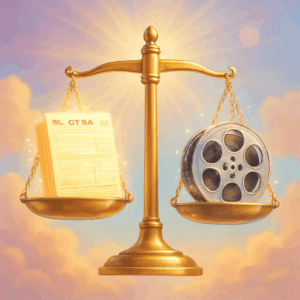
Free to Create, Free to Discriminate? Inside the 303 Creative Ruling Shaking Constitutional Law
On the last day of the Supreme Court’s 2023 term, a controversy over a wedding website that didn’t even exist set a pivotal precedent. In
Environmental law is a complex, dynamic, and rapidly evolving field. From climate change regulations to conservation policies, environmental law practitioners are constantly navigating a maze of statutes, regulations, and litigation. For legal professionals working in this space, understanding how environmental regulations have been enforced and interpreted in the past is vital to achieving success in future cases.
At The One Law Firm, we recognize the importance of case studies in shaping the practice of environmental law. By reviewing key cases, legal professionals can gain deeper insights into regulatory enforcement, successful legal strategies, and the challenges that persist in the field. In this article, we will explore how case studies have influenced the practice of environmental law, why they remain a valuable tool for legal professionals, and how our blog community at The One Law Firm will continue to provide a platform for the sharing of case studies, insights, and best practices.
Environmental law is inherently multifaceted, encompassing issues related to land use, natural resources, air and water quality, hazardous waste management, and wildlife conservation. As environmental laws evolve, case studies offer an invaluable resource for lawyers who need to navigate these complex issues. Through detailed case studies, legal professionals can understand not only how laws are applied but also how they are enforced in real-world situations.
Understanding Regulatory Enforcement
Environmental law is often enforced through regulatory agencies such as the Environmental Protection Agency (EPA), state-level environmental departments, and international regulatory bodies. The way these agencies interpret and apply the law in specific cases can significantly affect the outcome of future cases. Reviewing case studies allows environmental lawyers to see how regulatory bodies handle violations, compliance issues, and new legal interpretations.
Quote: “Environmental law is a constantly shifting landscape. Case studies help lawyers predict how agencies will respond to future challenges, whether in enforcement or litigation.” — Sarah L. Mitchell, Environmental Law Attorney at GreenFuture Legal Group.
Shaping Litigation Strategy
In environmental law, successful litigation often hinges on understanding how courts have ruled on similar issues in the past. Case studies provide insights into how judges have interpreted environmental statutes and regulations, as well as the arguments that have been most persuasive in court. Lawyers can use these insights to craft more effective legal strategies and arguments.
Example: A case study on a recent Clean Water Act enforcement action can reveal how a particular court handled jurisdictional issues or the scope of pollution violations, which could influence how future cases are presented.
Anticipating Future Trends in Environmental Law
Environmental law is shaped by societal concerns, political shifts, and scientific developments. As the global focus on climate change intensifies, new legal questions and challenges arise. Case studies provide a historical record of how courts and regulators have dealt with emerging environmental issues, allowing practitioners to anticipate how similar cases might be handled in the future.
Example: Recent case studies on carbon emissions regulations have demonstrated how courts are increasingly willing to address climate change-related lawsuits, providing a clearer picture of how future litigation in this area will unfold.
In the practice of environmental law, decision-making is often based on a blend of legal precedent, regulatory trends, and scientific evidence. Reviewing case studies provides legal professionals with a clearer understanding of how these factors intersect in real-world situations. Case studies help:
Clarify Complex Legal Questions
Environmental law often involves complex statutory frameworks that require nuanced interpretation. Case studies offer clarity by showing how specific legal questions have been resolved in the past. Whether it’s interpreting the scope of environmental protection under the National Environmental Policy Act (NEPA) or determining liability under the Comprehensive Environmental Response, Compensation, and Liability Act (CERCLA), case studies provide essential insights into how legal principles are applied.
Inform Risk Management Strategies
Environmental lawyers frequently advise clients on compliance, risk management, and potential exposure to liability. By studying case studies of previous enforcement actions, attorneys can assess the risks their clients may face in similar circumstances. Case studies help to identify potential pitfalls, offering a framework for minimizing legal and regulatory risks.
Example: A case study on a company facing a lawsuit for hazardous waste violations can inform how a legal team approaches a new case involving similar circumstances, from initial compliance strategies to litigation tactics.
Evaluate the Effectiveness of Policy Implementation
Case studies also allow lawyers to assess the effectiveness of various environmental policies. How successful have certain regulations been in reducing pollution or protecting endangered species? What loopholes have been exploited, and how have regulatory bodies responded? By analyzing these case studies, lawyers can better advocate for stronger policies or help clients navigate complex regulatory environments.
As beneficial as case studies are, it’s essential to use them strategically. Here are several best practices for effectively incorporating case studies into your environmental law practice:
Contextualizing Case Studies
Every environmental case is unique, and the context in which a decision was made is critical to understanding its implications. Legal professionals should look beyond the facts of a case and consider the broader political, social, and scientific context in which the decision was made. For example, cases involving climate change litigation may be influenced by shifting political priorities and growing public concern over environmental issues.
Looking for Patterns in Regulatory Enforcement
One of the key benefits of case studies is that they allow lawyers to identify patterns in regulatory enforcement. By examining how certain violations have been handled across multiple cases, practitioners can predict how similar violations will be addressed in the future. This predictive ability helps lawyers advise their clients on how best to comply with environmental laws or how to approach enforcement actions.
Engaging in Continuous Learning
Environmental law is a rapidly evolving field. New regulations, judicial decisions, and scientific advancements are continually shaping the landscape. It’s important for legal professionals to stay updated on the latest case studies and trends to ensure they remain at the forefront of the field. Engaging in continuous learning by reviewing recent case studies is essential for keeping up with changes in the law.
At The One Law Firm, we strive to provide legal professionals with the tools, resources, and insights they need to excel in environmental law. Our blog will serve as a platform for sharing case studies, best practices, and professional insights from experts in the field. Here’s how our blog will benefit you:
Comprehensive Case Study Reviews
Our blog will feature in-depth case study reviews that break down important environmental cases, analyzing their outcomes, strategies, and broader implications. These reviews will provide you with valuable lessons that you can apply to your own practice.
Contributions from Industry Experts
We will be hosting guest contributions from leading experts in environmental law. These articles will cover everything from the latest case law developments to practical strategies for navigating complex environmental regulations.
Interactive Knowledge Sharing
As part of our community, you can share your own case studies and insights. By submitting your own experiences, you’ll help contribute to a knowledge-sharing environment where lawyers can learn from each other and enhance their practice.
Case studies are a vital component of environmental law practice. By engaging with our blog, you can stay informed about the latest trends, contribute your own insights, and collaborate with other legal professionals to enhance the collective understanding of environmental law. Whether you’re sharing a case study from your own experience or offering your perspective on recent regulatory changes, your contributions will help others refine their strategies and build better, more effective legal practices.
We encourage you to submit your case studies, analyses, and professional insights. By sharing your knowledge, you’re not just enhancing your own practice—you’re helping to shape the future of environmental law.
The field of environmental law is complex and ever-changing, but case studies provide a roadmap to navigating the challenges it presents. By learning from past decisions, understanding regulatory trends, and refining legal strategies, practitioners can better advocate for their clients and influence future outcomes. At The One Law Firm, we believe in the power of case studies to transform the practice of environmental law and foster a community of continuous learning and collaboration.
We invite you to engage with our blog, share your own case studies, and contribute to a growing body of knowledge that will help shape the future of environmental law. Join us in building a stronger, more informed community of legal professionals.
Endnotes
Sarah L. Mitchell, Environmental Law Attorney, GreenFuture Legal Group.

On the last day of the Supreme Court’s 2023 term, a controversy over a wedding website that didn’t even exist set a pivotal precedent. In

How a pet‑food lawsuit became the Supreme Court’s cleanest answer yet to a messy removal problem—and what it means for every litigator who plays the

How a herring boat fight rewired U.S. administrative law—and what it means for agencies, regulated industries, and your litigation strategy. On a Friday morning at

How an unpublished Massachusetts opinion is quietly rewriting the rules of fiduciary warfare—and what every planner, litigator, and trustee should learn from the fallout. The

By TheOneLawFirm.com **“The express purpose of [§ 208(9)(o)] was to eliminate tax loopholes concerning royalty payments.” — Judge Cannataro, *Matter of Walt Disney Co.*¹ Long before Disney+ ever streamed a pixel in

How Adolph v. Uber Re‑wired California’s “Sue‑Your‑Boss” Law—and Why Labor Lawyers Everywhere Should Care By TheOneLawFirm.com “An order compelling arbitration of the individual claims does





